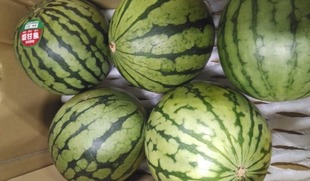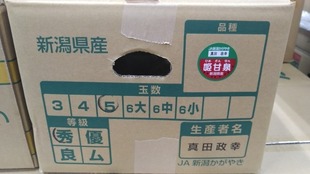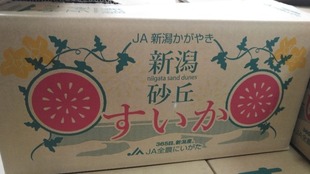Fujieda City held its first on-site lecture at the Ozu District Exchange Center in Ozu, the city, to support the creation of "My Timeline,'' an evacuation action plan in the event of a flood that was introduced in the spring of 2023. It will continue to be developed in response to citizen requests. Thirty-eight people participated, including local welfare committee members, children's committee members, and care managers. Employees from the city's flood control office served as instructors, checking the city's hazard map and the flood damage caused by Typhoon No. 15 last September, as well as checking the risk of flooding at their homes. Depending on the risk, evacuation methods were selected, such as vertical evacuation to the second floor of the residence or movement outside. The city will distribute this flood disaster version to all households in May. Prior to this, a landslide version was also distributed to target households in the warning area.
【Product name】
Fujieda Cow parsley from Shizuoka Prefecture【Type】
Cryptotaenia japonica
【生産地】
Osu, Fujieda City, Shizuoka Prefecture (Agri Hydroponic Farm Ltd., JA Oigawa)
【Origin of name】
Because three pretty leaves are attached to one stem.
【Major features】
Agriculture is an industry that produces food that is essential for people’s lives. It has various functions, such as the tradition of culture. It is also the source of the social infrastructure that In addition, the rural areas have formed the characteristics of Fujieda City, “moderately urban and moderately rural.” It seems that it is also a place to create the unique charm of this city that is not found in urban areas. If such agriculture and farming villages decline, it will not only cause economic loss in the form of a decline in food production, but also lead to a safe and secure way of life, a good living environment, and the attractiveness of the city. Was damaged, It seems that it will have a serious impact not only on farmers but also on citizens as a whole. Currently, Japan is facing an unprecedented rapid aging and declining population, and the farmer population in Fujieda City seems to be steadily declining. In addition, large-scale Frequent storms and floods, a decline in economic activity due to COVID-19, and a slump in the price of tea, a key crop, due to changes in consumer tastes It seems that the situation surrounding agriculture in this city is becoming extremely severe. On the other hand, with the expansion of overseas markets for Japan’s high-quality agricultural products and the advancement of technological innovations such as smart agriculture, the possibilities of agriculture have been realized. It seems that there is also a movement aimed at entering agriculture from a new field that has never existed before. In order to respond appropriately to this situation, seize opportunities, and develop the city’s agriculture and farming villages in the future, we must take a medium to long-term perspective. He argues that it is necessary to develop measures strategically. Therefore, in March 2015, the Fujieda City Agricultural and Rural Development Vision was formulated, and based on this vision, the promotion of agriculture and rural areas was carried out. It seems that they have been trying to The content has been revised to better reflect the current situation, and this report is intended to indicate the direction of basic policies and measures for the promotion of agriculture and farming villages in the future. Formulate a vision. The efforts of this plan are based on the Fujieda version of local We are promoting it in correspondence with the 17 goals of the SDGs and disseminating it widely. Furthermore, regarding the situation of farmers, the total number of farmers in Fujieda City decreased by 22.5% in the 10 years from 2005 to 2015. The number of commercial farmers seems to have decreased significantly by 36.7% over the same ten years. In the future, as the aging of society progresses further, 63.7% of commercial farmers have no successors. seems to be expected. While the number of part-time farmers has decreased significantly, the number of subsistence farmers has increased slightly, and the number of non-farmers who own land has increased significantly. Part-time farmers are shifting to subsistence farmers or land-owning non-farmers, and subsistence farmers are transitioning to land-owning non-farmers. It seems that it is speculated that there is a situation. On the other hand, for full-time farmers, he has increased by 12.7% in the same ten years, and the background. In 2008, part-time farmers became old and retired from their part-time farms, statistically shifting to the category of full-time farmers; It is thought that there are both positive and negative factors, such as the advance of foreign agricultural corporations and the new entry of non-agricultural companies. In order to realize “profitable agriculture” and make agriculture a sustainable industry, it is impossible to introduce new technologies such as large-scale management and smart agriculture. It seems to be missing. In addition, as the number of farmers decreased, the concentration of farmland to a small number of farmers accelerated. Expect to go. Under these circumstances, it is believed that the specialization of agriculture will progress further. In the future, we will promote the maintenance of agriculture in the city through the hands of farmers with active management intentions, mainly specialized farmers such as certified farmers and agricultural corporations. Based on the premise that it is necessary to maintain and develop farming, we will continue to support and train new farmers. At the same time, it is necessary to strengthen the management capabilities of existing farmers and to attract new players such as corporate management entities that are expected to operate large-scale and stable farming. He argues that there is a need to promote it. In terms of agricultural production, Fujieda City has very favorable conditions for cultivating crops, such as a mild climate and abundant sunshine, fertile land in the Seto River basin, and subsoil water from the Southern Alps. A wide variety of high-quality agricultural products such as rice, tea, paddy rice, mandarin oranges, lettuce, tomatoes, strawberries, flowers, etc. seems to be in production. In terms of sales and logistics, it is close to the Tokyo metropolitan area, which is the largest consumption area in Japan, and has transportation infrastructure such as interchanges on the Tomei Expressway and Shin-Tomei Expressway. It also seems to have an advantage over However, as the number of farmers and cultivated land under management has decreased in recent years, the value of agricultural output has continued to decline. price drop. As for mandarin oranges, another specialty of the city, although the period of market price stagnation due to temporary nationwide overproduction has passed, the production volume has yet to fully recover due to the aging and retirement of farmers. Sounds like a situation. On the other hand, the output value of vegetables is on the rise, and the shift from paddy rice to field crops, which are expected to be profitable, is progressing. It seems that the strong performance of strawberries can be considered as a factor. As the farmer population is expected to decline further in the future, in order to maintain and expand agricultural production, it will be necessary to develop next-generation agriculture that utilizes cutting-edge technology such as ICT. It seems that there is a need to simultaneously improve the labor saving and efficiency of agricultural work and improve the quality of agricultural products through the introduction of alternative agriculture. In addition, product development, brand Increasing the added value of agricultural products by planting new tencha varieties and introducing new high-profit crops, promoting local production and consumption, promoting local production and consumption It is important to carry out multifaceted efforts to improve the profitability of agriculture, such as promotion of consumption expansion through PR activities to the public. It also says it is necessary. At the time of 2018, it would not be an exaggeration to say that the most popular souvenir from Fujieda was the soccer ball-shaped Monaka (a round wafer filled with bean paste). It seems that it was made to commemorate the fact that Fujieda was the venue for the Shizuoka National Sports Festival in 1957. It is a famous confection with a history of over 60 years, and the retro box and wrapping paper are used at that time. It seems that it is currently sold at two stores in the city. The character is a combination of JA Oigawa’s farmer’s market “Mansaikan” and the animal “Sai”. “Mansai-kun” is a shy and quiet rhino boy (5 years old). My dream is to spread local agricultural products all over the country. “Fujieda City, Shizuoka Prefecture”, It has the second largest population after Shizuoka City. It is located in the central part and has a long terrain from north to south. It is long from north to south, and the northern part borders the southern tip of the Akaishi Mountains and is blessed with abundant greenery. The Shida Plain spreads to the south, and the Seto River runs through the city. Very comfortable with abundant flowers, greenery and water. Pale violet, whose image color is mauve and is the flower of the city, is familiar to the citizens and is crowded with many people at the Wisteria floribunda festival. In an area that is also famous as a “soccer city”. An ancient burial mound that drives curiosity about ancient times. Akunami Shrine: Tradition and style founded during the Emperor Nintoku era (316). The remains of a government office that looks at the political culture of the Heian period in Nara. The history of the castle that changed the Lord to Sengoku era as Imagawa-Takeda-Tokugawa. During the Edo period, it prospered as the 21st and 22nd post towns on the Tokaido. It seems that the streets that are not much different from Fujieda inn and Okabe inn at that time will remain. Merged with Okabe Town, which has developed as a post town of tokaido, on January 1, 2009. Fujieda Zero to Agriculture Entry System (Purpose): Until now, in principle, only farmers and new farmers who have undergone certain training could rent farmland, but the purpose is self-sufficiency and purpose in life. For those who cultivate as a farmer or those who aim to become farmers, the “Fujieda Zero Farming Entry System” was established, enabling the establishment of leasehold rights of 10 ares or less for farmland in specific areas, and the use of idle farmland. It seems to try to prevent and eliminate the outbreak and promote new farming. Areas with a lack of bearers and a considerable amount of idle farmland, the lower limit of Fujieda City’s permission requirement under Article 3 of the Agricultural Land Law, which is 30 ares or more, has been relaxed to 1 square meter or more for each block. From May 1, 2021, the “Fujieda Zero to Agriculture Entry System” will start. Be a new farmer. Depending on your farming experience, resources, and ability, it seems that you can rent farmland of 10 ares or less. Local discussion for formulating Fujieda City regional plan (mid-September 2022): Agriculture is an important industry that produces food that is essential for daily life. It seems that the maintenance of good farmland has become an urgent issue. Under these circumstances, the city is working toward the formulation of regional plans (district plans that summarize the way of regional agriculture and farmland utilization methods) based on the partial revision of the Act on Promotion of Strengthening Agricultural Management Bases, etc. Discussions will start in mid-August. For each of the nine regions in the people and farmland plans announced by last year, it seems that discussions will be held sequentially regarding the background and purpose of the law revision, an explanation of the procedure for formulating regional plans, and the areas where agricultural use will be carried out. From the region, the chairman of the agricultural department and certified farmers attend, and it seems that opinions are being exchanged while looking at the current map of farmland use created by the people and farmland plan. In the future, the prefecture plans to ask each municipality to set up a model district, identify issues in the course of supporting the formulation of regional plans, and reflect them in the creation of guidelines for formulating plans. “Yaizu City”, Located in the southern part of the Shida Plain, which extends to the central part of the prefecture. It has a warm climate and is blessed with natural conditions such as abundant water originating from the “Oi River”. In the plains, in addition to rice, facilities vegetable, tomatoes, strawberries, chrysanthemums, etc., mainly open-field vegetables. In the mountains, we develop highly intensive agriculture such as tea and mandarin oranges. The strength of the proximity of production and consumption areas. Infiltrate local residents and develop agriculture where the face of producer can be seen from the perspective of local production local for consumption. In the industry, the fishery distribution and processing industry is thriving, and the quality and quantity are the highest in Japan. Along with this, the production of marine machinery and fishery processing machinery is also active, and it plays a major role in the city’s industrial sector. Yaizu Port: Katsuwonus pelamis and Thunnus are mainly landed as bases for pelagic fisheries. A generic term for the two ports of Kogawa, where horse mackerel, Morth Borneo, etc. are landed in the coastal waters: Yaizu fishing port. Oi-gawa Port where lucensosergia lucens, which can only be caught in Whitebait and Suruga Bay, is landed. Tokutei Daisanshu Gyoko (a specific third-kind fishing port or nationally important fishing port): A fishing port that is especially important for the promotion of the fishing industry. It boasts one of the largest landings in Japan. etc. A warm climate with an average annual temperature of 16.5 degrees Celsius and rare winter snowfall. The area is 70.31km2. Fujimori’s Taasobi rice planting ritual (May 17, 1977; Fujimori, Yaizu City). Most of the arable land in the city is flat land, 80% of which is rice paddy. The main brands are Koshihikari rice, Aichi no Kaori rice, and Kinumusume rice, and rare varieties such as ancient rice (red rice, black rice) and Milky Queen rice are also produced in the prefecture. In recent years, the cultivation of Homare Fuji, a sake rice variety developed in Shizuoka Prefecture, has become popular, with Yaizu City boasting 60% of the production in the prefecture. Producers in the city have set up the “Yaizu sake rice study group” and are actively promoting it, so please refer to it. In 1966, tomatoes were designated as a production area by the Japanese government. It seems that they mainly produce Momotaro tomatoes, but also cherry tomatoes, medium tomatoes, and high sugar content tomatoes. It seems that strawberries began to be cultivated in Shizuoka around the early Meiji period. At Agri Hydroponic Farm Co., Ltd., hydroponics is a type of hydroponics, in which vegetables are grown in a culture solution in which nutrients are dissolved in water without using a medium. Liquid fertilizer is the nutrient. Because it is mainly cultivated in facilities such as greenhouses, it is less affected by the season and is less likely to be damaged by external factors such as insects and diseases. Because it does not use soil, it is said that hygiene management is easier than soil cultivation. Generally, anthriscus sylvestris is grown in the spring, when it is in season, but now it seems that it can be harvested all year round. In the case of soil cultivation as a cultivation method, the seeds are soaked in water overnight, sown shallowly in the soil, and the sprouts are thinned out. It is relatively vulnerable to high temperatures and dryness, so caution is required. In order to grow a good anthriscus sylvestris, it also needs moderate light and fertilizer. Harvest is possible when the green leaves have grown just right. In addition to soil cultivation, hydroponic cultivation seems to be attracting attention recently. It is said that anthriscus sylvestris, which has been cultivated in soil for a long time, began to grow soft white in Mizumoto Town, Katsushika, Tokyo during the Kyoho era, and then spread throughout the Kanto region after being improved in Matsudo, Chiba Prefecture. (It seems that soft whitening technology was introduced in the Kansai region after the Meiji period.) The current hydroponics using large greenhouses is said to have started in Hamamatsu City in the mid-1965s, and has been planted many times a year. The short growing season and year-round availability of anthriscus sylvestris make it a suitable crop for solution cultivation.

DFT is a method of cultivating vegetables by floating them in a circulated culture medium. It seems that it is necessary to keep sending air because the culture solution becomes deep and lacks oxygen. Mitsuba, green onions, bok choy, etc. are cultivated using this method. In addition, it seems that there is also a method of creating a shallow flow of culture solution in the cultivation bed, allowing the roots of the crop to grow there and absorb moisture and nutrients.Since the upper part is exposed to the air, there is no shortage of oxygen. Absent. Salad greens, spinach, herbs, etc. seem to be cultivated in this way. In addition, it seems that rockwool is a culture medium made by melting rocks at high temperatures and turning them into wool-like fibers into plates of several centimeters, and containing plenty of culture fluid and air. The culture solution is given like an infusion to the medium. Tomatoes, peppers, roses, etc. seem to be grown this way.

Mitsuba is produced by a method of soaking the roots in nutrient-dissolved water (hydroponics) without using soil. Hydroponics creates an environment suitable for mitsuba, so it grows quickly, and after planting, it takes about 45 to 50 days in winter and 30 to 35 days in spring to harvest. This cycle is repeated 7-8 times a year, making it possible to cultivate and ship year-round.









